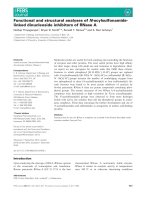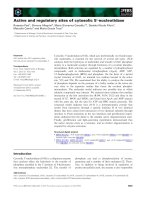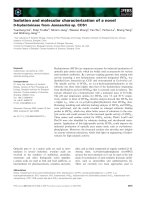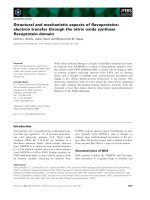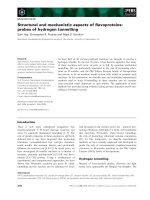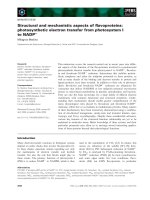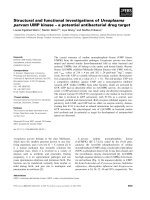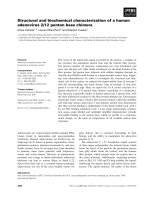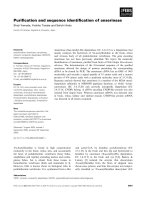Báo cáo khoa học: Temperature and concentration-controlled dynamics of rhizobial small heat shock proteins doc
Bạn đang xem bản rút gọn của tài liệu. Xem và tải ngay bản đầy đủ của tài liệu tại đây (489.4 KB, 10 trang )
Temperature and concentration-controlled dynamics of rhizobial
small heat shock proteins
Nicolas Lentze
1
, J. Andrew Aquilina
2
, Mareike Lindbauer
1
, Carol V. Robinson
2
and Franz Narberhaus
1,3
1
Institut fu
¨
r Mikrobiologie, Eidgeno
¨
ssische Technische Hochschule, Zu
¨
rich, Switzerland;
2
Department of Chemistry, Cambridge
University, Cambridge, UK and
3
Lehrstuhl fu
¨
r Biologie der Mikroorganismen, Ruhr-Universita
¨
t Bochum, Bochum, Germany
A hallmark of a-crystallin-type small heat shock proteins
(sHsps) is their highly dynamic oligomeric structure which
promotes intermolecular interactions involved in subunit
exchange and substrate binding (chaperone-like activity).
We studied the oligomeric features of two classes of bacterial
sHsps by size exclusion chromatography and nanoelectro-
spray mass spectrometry. Proteins of both classes formed
large complexes that rapidly dissociated upon dilution and
at physiologically relevant heat shock temperatures. As the
secondary structure was not perturbed, temperature- and
concentration-dependent dissociations were fully reversible.
Complexes formed between sHsps and the model substrate
citratesynthasewerestableandexceededthesizeofsHsp
oligomers. Small Hsps, mutated in a highly conserved gly-
cine residue at the C-terminal end of the a-crystallin domain,
formed labile complexes that disassembled more readily
than the corresponding wild-type proteins. Reduced com-
plex stability coincided with reduced chaperone activity.
Keywords: a-crystallin; chaperone; oligomerization; sHsp;
small heat shock protein.
Small heat shock proteins (sHsps or a-Hsps) form a distinct
family of molecular chaperones. They are found in most
organisms and are typically induced upon stress [1–3]. Most
sHsps tested, to date, prevent thermal- or chemical-induced
aggregation of a variety of model substrates in vitro by
binding to unfolding intermediates. The resulting sHsp–
substrate complexes are very large and stable [4–8]. In
contrast to other chaperones, the chaperone activity of
sHsps is generally believed to be ATP-independent. As a
consequence, sHsps lack refolding activity. Upon binding
to sHsps, partially denatured proteins are maintained in a
refoldable state, promoting subsequent refolding in cooper-
ation with ATP-dependent chaperones [6–8]. Recently, it
was shown that the release and subsequent refolding of
sHsp-bound substrates is efficiently mediated by ClpB/
DnaK [9].
sHsps exhibit a low molecular mass of % 12–43 kDa. A
typical feature is the formation of large oligomeric com-
plexes, often exceeding 500 kDa [10]. Both poly- and
monodisperse quaternary structures have been reported
for eukaryotic and prokaryotic sHsps [11–14]. Two sHsp
structures were solved by X-ray crystallography: Methano-
coccus jannaschii Hsp16.5 was shown to form a hollow,
football-like 24-mer structure, whereas wheat Hsp16.9 is
organized as a dodecameric double disk [15,16]. Despite the
difference in the quaternary structure, the monomeric fold
of both sHsps is very similar and, in each case, dimers are
probably the main building units of the complex. Several
studies have shown that sHsp complexes are very dynamic
in terms of intersubunit exchange and dissociation/reasso-
ciation processes [17–21]. The dynamic behaviour is thought
to be interrelated to substrate interaction. Exposure of
hydrophobic patches (which are putative substrate-binding
sites) upon heating, was demonstrated for several sHsps
[5,14,22].
Bacterial sHsps can be divided into two classes – A and B
– according to their primary structure [23,24]. Like other
rhizobial species, the nitrogen-fixing soybean symbiont,
Bradyrhizobium japonicum, contains both classes. The
recently established total genome sequence revealed 11
sHsp genes, seven coding for class A and four coding for
class B proteins [25]. Members of both classes were shown
to form large complexes and to protect the model substrate
citrate synthase (CS) from thermal aggregation in vitro [26].
Formation of mixed oligomers is restricted to members
of the same class. Recently, we have shown that class A
complexes of HspH are in a concentration-dependent
equilibrium with smaller subspecies [27]. HspH exchanged
subunits at temperatures well below those needed for heat-
induced sHsp expression in B. japonicum. The oligomeric
state of HspH did not seem to respond to heat treatment
as preincubation up to 55 °C did not change migration on a
gel-filtration column when chromatography was performed
at room temperature.
There is strong evidence that complex size and chaper-
one activity are linked. Mutations, and N- and C-terminal
truncations of B. japonicum class A and class B proteins,
which led to smaller complexes, were accompanied by
decreased chaperone activity [27,28]. The only exception
was a mutation of a highly conserved glycine (G114) in the
Correspondence to F. Narberhaus, Ruhr-Universita
¨
tBochum,
Lehrstuhl fu
¨
r Biologie der Mikroorganismen, Geba
¨
ude
NDEF 06/783, D-44780 Bochum, Germany.
Fax: + 49 234 321 4620, Tel.: + 49 234 322 3100,
E-mail:
Abbreviations: CS, citrate synthase; nanoESI-MS, nanoelectrospray
mass spectrometry; SEC, size exclusion chromatography;
sHsps, small heat shock proteins.
(Received 8 March 2004, revised 19 April 2004,
accepted 22 April 2004)
Eur. J. Biochem. 271, 2494–2503 (2004) Ó FEBS 2004 doi:10.1111/j.1432-1033.2004.04180.x
central a-crystallin domain (named after the human lens
protein, a-crystallin) of HspH. The G114A protein was
wild-type-like in terms of complex formation and hetero-
oligomerization, but impaired in chaperone activity. Thus,
it was speculated that G114 might be involved in substrate
binding [27].
In the present study, we investigated the influence of
temperature and concentration on sHsp complexes by two
different techniques, namely size exclusion chromatogra-
phy (SEC) and electrospray ionization mass spectrometry
(ESI-MS). Several recent studies have demonstrated that
ESI-MS is a powerful technique to study large, noncova-
lent protein complexes [29,30]. We show, in the present
study, that the size of B. japonicum class A and class B
sHsp complexes is adjusted to the ambient temperature
and to protein concentration, and that mutant proteins
equivalent to HspH(G114A) form unstable complexes.
Materials and methods
Bacterial strains and plasmids
Escherichia coli DH5a, grown in LB (Luria–Bertani)
medium, was used for recombinant DNA techniques,
according to standard protocols [31]. Construction of
pET-derived plasmids for the production of B. japonicum
HspB
His
(pRJ5304), HspH
His
(pRJ5307), HspC
His
(pRJ5305) and HspF
His
(pRJ5306), has been described
previously [26]. The HspB
His
derivative, HspB
His
(G116A)
(pRJ5691), was constructed by primer-based site-directed
mutagenesis (Quick-Change
TM
Site-Directed Mutagenesis
Kit; Stratagene), using pRJ5304 as the template. Mutagen-
esis was performed according to the manufacturer’s instruc-
tions. The correct nucleotide sequence was confirmed by
automated DNA sequencing. All sHsps used in this study
carry a C-terminal hexahistidine tag.
Protein expression and purification
E. coli BL21(DE3)pLysS was freshly transformed with
expression plasmids. Inoculated cultures were grown at
30 °C to an attenuance (D), at 600 nm, of 0.6, before
expression was induced by the addition of isopropyl thio-
b-
D
-galactoside (0.5 m
M
). After 2 h, cells were harvested
and resuspended in binding buffer [500 m
M
KCl, 20 m
M
Tris/HCl, 5 m
M
imidazole, 10% (v/v) glycerol, pH 7.9]
containing 1 m
M
phenylmethanesulfonyl fluoride and
10 lgÆmL
)1
DNase I. Cells were lysed in a French pressure
cell at 1000 p.s.i. Soluble crude extracts were obtained after
centrifugation at 12 000 g for 30 min at 4 °C. Protein
purification was carried out under native conditions by
affinity chromatography using Ni-nitrilotriacetic acid resin
(Qiagen), as described previously [26,27]. Purified proteins,
not used within a few days, were stored at )20 °Cor)80 °C
in elution buffer [500 m
M
KCl, 20 m
M
Tris/HCl, 250 m
M
imidazole, 10% (v/v) glycerol, pH 7.9].
Chaperone activity assay
The ability of HspB and HspB(G116A) to protect CS
from thermally induced aggregation was monitored over
a time-period of 31.5 min. Different concentrations of
HspB and HspB(G116A), in 1 mL of 50 m
M
sodium
phosphate buffer (pH 6.8), were preincubated for
10–15 min at 43 °C prior to the addition of CS to a
final concentration of 600 n
M
. CS aggregation was
measured as increased light scattering at 360 nm, in an
Ultrospec 3000 spectrophotometer (Amersham Pharmacia
Biotech). CS (Sigma) was dialyzed against Tris/EDTA
buffer (10 m
M
Tris/HCl, 1 m
M
EDTA, pH 8.0) and
stored at )20 °Cbeforeuse.
Gel filtration
Standard size-exclusion chromatography was performed on
a Superdex 200 HR 30/10 column (Amersham Pharmacia
Biotech), as described previously [27,28]. For gel filtration
at different temperatures, a 10 · 600 mm Superformance
column (Merck), equipped with a temperature adjustable
jacket connected to a water bath, was packed with
Sephacryl S-300 HR (Amersham Pharmacia Biotech).
The columns were equilibrated with elution buffer
[500 m
M
KCl, 20 m
M
Tris/HCl, 250 m
M
imidazole, 10%
(v/v) glycerol, pH 7.9]. Sample aliquots of 200 lLwere
injected and separated on a BioCAD perfusion chromato-
graphy system (PerSeptive Biosystems), at a flow rate of
1.0 mLÆmin
)1
on the Sephacryl column and at 0.6 mLÆmin
)1
on the Superdex column. Absorbance was recorded at a
wavelength of 280 nm. The systems were calibrated with
the following proteins from Amersham Pharmacia Biotech:
thyroglobulin (699 kDa), ferritin (440 kDa), aldolase
(158 kDa), albumin (67 kDa) and ribonuclease A
(13.7 kDa).
CD spectroscopy
Far-UV spectra in the range of 200–260 nm were recorded
on a BioLogic scanning spectrometer MS450 equipped with
a water bath connected to the cuvette chamber. Proteins
were suspended at 100 lgÆmL
)1
in potassium phosphate,
KF buffer (50 m
M
potassium phosphate, 100 m
M
KF,
pH 7.0). The path length of the cuvette was 2 mm. The
reported spectra are the average of five scans fitted by the
fifth order polynomial function. Blank corrections were
performed at each temperature.
MS
Frozen aliquots of purified HspF and HspC were thawed at
room temperature and concentrated using Millipore Ultra-
free-0.5 Biomax 5 kDa devices. The concentrated protein
was buffer exchanged by loading 120 lL onto a Superdex
200 HR 10/30 size-exclusion column (Amersham Pharma-
cia) and eluting at 0.4 mLÆmin
)1
with 200 m
M
ammonium
acetate, at 8 °C. Fractions corresponding to the major
eluting peak were pooled and concentrated to 1.4 mgÆmL
)1
using the Biomax centrifugal filters.
Nanoelectrospray MS (nanoESI-MS) experiments were
performed on an LCT mass spectrometer (Micromass UK
Ltd). Typically, 2 lL of solution was electrosprayed from
gold-coated glass capillaries prepared in-house. In order to
preserve noncovalent interactions, the following instrument
parameters were used: capillary voltage, 1.5 kV; cone gas,
100 LÆh
)1
; sample cone, 170 V; extractor cone, 8 V; ion
Ó FEBS 2004 Dynamics of bacterial sHsps (Eur. J. Biochem. 271) 2495
transfer stage pressure, 8.0 · 10
)3
mbar; and ToF analyzer
pressure, 1.4 · 10
)6
mbar. Thermal dissociation experi-
ments were carried out using a thermocontrolled nanoESI
probe designed in-house [30]. NanoESI capillaries, contain-
ing HspF, were pre-equilibrated at the temperatures indi-
cated, for 60 s prior to data acquisition. All spectra were
calibrated externally using a solution of cesium iodide, and
processed using
MASSLYNX
software (Micromass UK Ltd).
The peak series were identified manually. A mass was
generated based on an algorithm built into the
MASSLYNX
software, where m/z-1 for two consecutive charge states
was multiplied and then divided by the difference between
the m/z values.
Results
Temperature- and concentration-dependent
oligomerization of class A proteins
HspH oligomers have been previously shown to dissociate
into smaller particles upon dilution [27]. Like all other
B. japonicum sHsps investigated to date, they were found
to partition into two fractions during gel filtration on a
Superdex 200 HR 30/10 column [27,28]. One peak coincided
with the void volume of the column, whereas the other
represented a dynamic concentration-dependent fraction.
Two distinct peaks were also observed in the present study,
during SEC on a temperature-adjustable Sephacryl S-300
HR column (Fig. 1A, solid line). The second peak of a
sample with a concentration of 1 mgÆmL
)1
eluted at
% 200 kDa at room temperature. Preincubation of the
protein at 40 °C did not result in a shift of the peak when
subsequent gel filtration was performed at room tempera-
ture (broken line). In contrast, the HspH complex dissoci-
ated and eluted at % 70 kDa when the column was run at
40 °C (dotted line).
To examine, more closely, the temperature-dependent
dissociation process, SEC of HspB, another class A protein,
was performed at six different temperatures (Fig. 1B).
Almost the entire fraction eluted in the void volume
(>1.5MDa)at4°C. Much smaller oligomers, with a
peak of % 300 kDa, were observed at 25 °C. The
equilibrium shifted towards smaller species at increasing
temperatures, finally resulting in a retention time, corres-
ponding to 40 kDa, at 45 °C. As for HspH, the disassembly
process was fully reversible (Fig. 1C). In contrast, the
Fig. 1. Reversible, temperature-controlled dissociation of class A pro-
teins. Gel filtration was performed on a Sephacryl S-300 HR column
andproteinelutionwasmonitoredbyabsorptionat280nm.The
protein concentration was 1 mgÆmL
)1
for HspH and 2 mgÆmL
)1
for
HspB. (A) Elution profiles of ice-cooled HspH injected onto the col-
umn equilibrated at 25 °C (––) or 40 °C(ÆÆÆÆ), and of a sample recorded
at 25 °C after incubation for 15 min at 40 °C and cooled on ice (- - -).
The derived molecular mass values of the main peaks were 214 kDa,
75 kDa and 207 kDa, respectively. (B) Ice-cold HspB samples were
injected onto the column equilibrated at the temperatures indicated.
The determined molecular masses (indicated from 4 °Cto45°C) were
‡1.5 MDa, and 296, 229, 147, 75 and 43 kDa. (C) Elution of an HspB
sample incubated at 43 °C for 15 min, cooled on ice and analyzed on
the column equilibrated at 25 °C. The elution times of peaks from
samples run at 25 °Cand43°C in (B) are indicated. (D) Gel filtration
calibration curves at 25 °C(m, ––) and 40 °C(n, )withstandard
proteins: thyroglobulin (669 kDa), ferritin (440 kDa), aldolase
(158 kDa), albumin (67 kDa) and ribonuclease A (13.7 kDa).
2496 N. Lentze et al. (Eur. J. Biochem. 271) Ó FEBS 2004
elution of standard proteins was completely independent
of temperature (Fig. 1D).
Temperature- and concentration-dependent
oligomerization of class B proteins
A temperature-controlled shift towards smaller species,
similar to that found with class A proteins, was observed
with HspF, a class B sHsp (Fig. 2A). The protein was
previously shown to form oligomeric species of % 400 kDa
[28]. On the Sephacryl material, it eluted at % 100 kDa, when
injected from a sample with a concentration of 3 mgÆmL
)1
,
at 25 °C. At 45 °C, the protein eluted as a complex of
% 30–40 kDa. As with class A proteins, the oligomeric state
adjusted rapidly to the temperature, as shown by the
injection of ice-cooled samples onto the pre-equilibrated
column. The particle size also correlated with protein
concentration (Fig. 2B). HspF eluted as a small oligomer
when it was injected from a diluted sample (0.5 mgÆmL
)1
).
NanoESI-MS was used to confirm the effects of concen-
tration and temperature upon the oligomerization of the
class B sHsps. When HspC (1.4 mgÆmL
)1
) was analyzed at a
temperature of 30 °C, a spectrum containing a distribution
of oligomers from 12 to 24 subunits was obtained (Fig. 3A).
In this case, the predominant species consisted of 18
subunits (18mer) with a molecular mass of 356 kDa, within
an oligomeric range of 238–476 kDa. When this sample was
diluted fourfold and analyzed under identical MS condi-
tions, the major species was found to be a 12mer protein.
This decrease in the relative population of species greater
than 238 kDa is consistent with a reduction in the overall
average molecular mass of the polydisperse assemblies
observed by gel filtration.
In order to assess the quaternary changes associated
with temperature, HspF (0.7 mgÆmL
)1
) was equilibrated
at a range of temperatures prior to online analysis by
nanoESI-MS. At 14 °C, the ratio of 12mer (the major
oligomer at this concentration) to dissociated species
(monomer and dimer) was 1 : 1, based upon peak areas in
the spectrum (Fig. 4). This indicated that a substantial
proportion of the HspF monomers was involved in
Fig. 2. Temperature and concentration-dependent dissociation of the
class B protein, HspF. (A) Gel filtration profiles of ice-cold HspF
samples run on a Sephacryl S-300 HR column equilibrated at the
temperatures indicated. The protein concentration was 3 mgÆmL
)1
.
The derived molecular masses (indicated from 4 °Cto45 °C) were 338,
110, 80, 61, 45 and 38 kDa. (B) Elution profile at 25 °Cofasample
diluted from 3 mgÆmL
)1
(arrow) to 0.5 mgÆmL
)1
.
Fig. 3. Concentration-dependent dissociation of HspC monitored by
nanoelectrospray MS (nanoESI-MS). (A) NanoESI mass spectrum of
HspC (1.4 mgÆmL
)1
)in200m
M
ammonium acetate, pH 7.0. Charge
state series from a range of oligomers were observed between m/z 6500
and m/z 10 000. These charge states were used to assign the peaks to
oligomers ranging from 12 to 24 subunits in size, centred around a
major species containing 18 subunits. (B) Reanalysis, under identical
conditions, after dilution of the sample to 0.35 mgÆmL
)1
. The spectrum
contained ions within the same m/z range; however, a shift to lower
molecular mass species was observed, such that ions arising
from a dodecamer represented the major species in the spectrum.
Representative charge states of the associated oligomers (Xmer
Y+
)
are shown.
Ó FEBS 2004 Dynamics of bacterial sHsps (Eur. J. Biochem. 271) 2497
higher-order oligomerization at this temperature. It is
important to emphasize that the monomer signal arises
from a single molecule, whereas the dodecamer signal is
obtained from 12 subunits. Thus, the actual number of
subunits involved in dodecamers at 14 °Cismuchgreater
than monomers (dimers) at this temperature. At 20 °C,
a similar ratio was observed. When HspF was heated to
31 °C, however, a dramatic shift in the ratio of 12mer to
dissociated species was observed, such that ions arising
from the dodecamer were reduced to % 40% of those
arising from the dissociated species (inset). A sample
equilibrated at 42 °C produced a further (slight) decrease
in this oligomeric ratio. The peaks around m/z 2000 arise
from truncated species of 14.2, 15.7 and 16.6 kDa that
were not associated with the dodecamer under MS
conditions.
Instability of HspB mutated in a highly conserved
G residue
Previously we have shown that the class A HspH(G114A)
mutant is a defective chaperone, despite wild-type-like
oligomerization [27]. G114 corresponds to one of the most
highly conserved residues of sHsps [1]. To further investigate
this site, a corresponding mutation was constructed in
another class A protein. HspB(G116A) eluted as a 360 kDa
complex when analyzed at 25 °C on a Superdex 200 HR 10/
30 column. At 2 mgÆmL
)1
, HspB formed a larger complex
of % 600 kDa (Fig. 5A). Like the equivalent HspH mutant
HspB(G116A) was a defective chaperone unable to prevent
temperature-induced aggregation of the model substrate,
CS (Fig. 5B). To test the thermal stability of the sHsp
complexes, SEC was performed at different temperatures.
At 25 °C, wild-type HspB eluted as a 370 kDa complex on
the Sephacryl material (Fig. 5C), whereas HspB(G116A)
complexes were clearly reduced in size. A peak in the range
of 140 kDa was observed (Fig. 5D). Likewise, the HspB
peak, at % 40 kDa at 45 °C (Fig. 5C), was shifted to
20 kDa in the case of the mutated protein (Fig. 5D).
Temperature-induced dissociation was fully reversible in
either case (data not shown, Fig. 1C).
Temperature-resistant secondary structure of class A
and class B proteins
Far-UV CD spectroscopy was performed in order to
determine whether the temperature-dependent changes in
oligomerization were accompanied by alterations in the
secondary structure. The traces recorded are typical of
b-strand proteins and show a single minimum elipticity in
the range of 217 nm, similar to that observed for other
sHsps [14,18,32]. The spectra of HspH (Fig. 6A) or HspF
(Fig. 6B), taken at 23 °C, 33 °Cor43 °C, were very similar,
indicating that significant changes in the secondary structure
do not occur in the physiological temperature range.
Formation of large sHsp–substrate complexes
B. japonicum sHsps have been shown to prevent heat-
induced aggregation of the model substrate, CS [26]. The
formation of sHsp–CS complexes was examined by gel
filtration. When HspH and CS were incubated together on
ice for 50 min prior to injection, three peaks were detected
by SEC (Fig. 7A, solid line). To analyze the composition of
these peaks, fractions were collected and separated by SDS-
PAGE (Fig. 7B). CS eluted with a retention time consistent
with its molecular mass (dimer, 96 kDa). Some HspH was
found in the void volume fraction, but the majority resided
in a broad peak, reflecting its concentration-dependent
dissociation. Co-incubation of HspH and CS at 43 °C
before SEC resulted in a significant increase of the void
volume fraction and a decrease of dimeric CS and the
second HspH peak (Fig. 7A, broken line), indicative of
the formation of large and stable chaperone–substrate
Fig. 4. Temperature-dependent dissociation of HspF monitored by nanoelectrospray MS (nanoESI-MS). Spectra were acquired at the temperatures
indicated after pre-equilibration in the nanoelectrospray capillary. Charge states arising from a dodecamer were observed between m/z 6200 and m/z
7000, whereas those arising from monomers and dimers (dissociated species) were observed in the range m/z 1980 and m/z 3400. A substantial
decrease in peak intensities of the 12mer charge state series was observed with increased temperature, particularly between 20 °Cand31°C. The
most abundant species was adjusted to 100% peak intensity. (Inset) Graph of the ratio of summed peak areas for charge state series of the 12mer
relative to the dissociated species. Hsp70/DnaK was a co-purified contaminant from the Escherichia coli expression system.
2498 N. Lentze et al. (Eur. J. Biochem. 271) Ó FEBS 2004
assemblies. A transfer of CS and HspH into the void
volume, at the expense of the other fractions, was confirmed
by SDS-PAGE (Fig. 7C). Neither HspH nor CS shifted into
the void volume when they were heat-treated separately
before gel filtration (data not shown).
Discussion
Oligomerization of sHsps responds to external conditions
Most sHsps are highly dynamic proteins which form flexible
oligomeric complexes that frequently exchange subunits by
dissociation and reassembly. Although we are far from a
consistent picture, it is well documented that at least two
parameters have a strong impact on the composition of
sHsp complexes. The average complex size often depends
on protein concentration and temperature. Dilution-
induced disassembly is usually reflected by broad and
tailing peaks when sHsps are run on a gel-filtration column.
During recent studies on sHsp mutants, oligomers of the
class A protein, HspH, were found to be in a concentration-
dependent equilibrium with smaller subspecies [27]. In the
present study, we demonstrate that concentration-depend-
ent dissociation is a general property of B. japonicum sHsps,
as the class A protein, HspB, and the class B proteins, HspC
and HspF, behaved in an identical manner. Closer inspec-
tion, by ESI-MS, revealed that the predominant species in a
concentrated sample of HspC were 18mers. The presence of
larger (20, 22 and 24mer) and smaller (16 and 12mer)
particles indicates a dynamic composition from which
dimeric particles are released upon dilution. The appearance
of glutaraldehyde cross-linked sHsp dimers on SDS-PAGE
gels (data not shown) supports the notion that they might be
the main building units of class A and B proteins. Dimers
are also the basic building blocks of M. jannaschii Hsp16.5
and wheat Hsp16.9. The dimerization interface was shown
to form the most extensive contacts in the oligomeric
complex [15,16]. Likewise, unfolding of a yeast Hsp26 dimer
required much higher energy, as compared to the relatively
low energy needed for dissociation of the 24mer into dimers
[33]. Real-time subunit exchange, monitored by ESI-MS,
demonstrated that the closely related pea Hsp18.1 and
wheat Hsp16.9 exchanged dimers as the main unit [17]. In
Fig. 5. Temperature-dependent dissociation and chaperone activity of
wild-type HspB compared to HspB(G116A). (A) Gel filtration profiles
of HspB (––) and HspB(G116A) (- - -). The molecular masses were
determined as 600 and 360 kDa, respectively. The protein concentra-
tion was 2 mgÆmL
)1
. Size exclusion chromatography was carried out
on a Superdex 200 HR 10/30 column at 25 °C. (B) Thermal aggre-
gation of citrate synthase (CS) at 43 °C in the presence of different
concentrations of HspB or HspB(G116A) was recorded at 360 nm.
The CS assay was performed in the absence (r) and presence of
150 n
M
(n), 300 n
M
(m), 600 n
M
(h)and1.2l
M
(j)ofHspBpro-
teins. The CS concentration was 600 n
M
. HspB alone was measured at
1.2 l
M
(e). Ice-cold HspB (C) or HspB(G116A) (D) samples were
separated on the Sephacryl S-300 HR column equilibrated at the
indicated temperatures. The protein concentration was 2 mgÆmL
)1
.
The molecular mass values were (indicated from 25 °Cto45°C) 370,
210, 110, 65 and 40 kDa for HspB and 140, 65, 40, 25 and 20 kDa for
HspB(G116A). As protein eluting in the void volume does not con-
tribute to the equilibrium (data not shown), only the dynamic fractions
were compared at similar concentrations, as indicated by the dotted
lines.
Ó FEBS 2004 Dynamics of bacterial sHsps (Eur. J. Biochem. 271) 2499
contrast, the hexadecameric murine Hsp25 was shown to be
in concentration-dependent equilibrium with tetramers [34].
Concentration-dependent oligomerization is not a feature
common to all sHsps. Temperature-controlled dissociation
seems to be more common. However, again it is not
a unifying feature of all sHsps. Neither a-crystallin nor
Hsp42 are temperature-responsive [5,35]. This reflects the
physiological conditions under which these proteins are
active. The a-crystallins serve two important functions in
the eye lens: a structural role; and a protective, chaperone-
like function [36]. As the mammalian eye rarely encounters
major temperature fluctuations, thermal control of these
functions is not applicable. Similarly, Hsp42 is an abundant
sHsp in yeast, serving its important chaperoning task at
room temperature [35]. Hence, its oligomeric state is not
influenced by temperature. Hsp26, the second sHsp in yeast,
is, however, a temperature-controlled chaperone that
dissociates at heat shock temperatures [5]. At low temper-
atures it associates into an inactive storage form.
Our SEC and ESI-MS experiments consistently dem-
onstrate that both class A and class B sHsps form large
Fig. 6. Far-UV CD spectroscopy of HspH (A) and HspF (B). Spectra
were recorded at the indicated temperatures. The data represent the
average of five scans from a sample containing 100 lgÆmL
)1
protein.
The path length was 2 mm. The mean residue ellipticity was calculated
from the following equation:
ðhÁM
MRW
Þ=ð10ÁcÁlÞ;
where MRW ¼ mean residue molecular mass; c ¼ concentration
(mgÆmL
)1
); and l ¼ path length (cm).
Fig. 7. Complex formation between HspH and citrate synthase (CS).
(A) Gel filtration on a Superdex 200 HR 10/30 column of 20 l
M
HspH
that was preincubated for 15 min at 43 °C before the addition of 2 l
M
CS and incubation for an additional 50 min at the same temperature
(- - -). As a control, a sample containing CS (2 l
M
)andHspH(20 l
M
),
which was incubated on ice for 50 min prior to size exclusion chro-
matography, is shown (––). Protein from the control sample (B) and
the heat-treated sample (C) was collected, precipitated, separated by
SDS-PAGE and stained with Coomassie blue. Lanes 1 and 2 corres-
pond to the peak that eluted at around 12.5 min (void volume). Lanes
3–6 represent the two peaks that eluted between 19 and 26 min.
2500 N. Lentze et al. (Eur. J. Biochem. 271) Ó FEBS 2004
complexes that are very sensitive to dilution and tem-
perature. Even moderate temperature changes, in the
range between 25 °Cand35°C,ledtoasignificant
decrease in complex size. The monomers observed in the
ESI-MS probably do not represent the actual in vivo state,
but rather are a result of dimer dissociation in the MS
process. The sHsps are presumably held together largely
by hydrophobic interactions, the effects of which are
greatly reduced during the electrospray process where the
solvent is removed from the gas-phase droplets. The
interactions of the dodecamer are presumably stronger
than the dimer owing to a greater unexposed surface area,
leading to the observation of more dodecamer at lower
temperatures. The dimer, however, dissociates to mono-
mer to the same extent, as this is an MS phenomenon,
not a temperature-related transition. Taken together, this
would explain why the distribution differs between MS
and SEC.
The significant decrease in complex size between 25 °C
and 35 °C agrees well with the physiological demands.
Growth of B. japonicum is optimal at % 30 °C. At higher
temperatures, heat shock proteins are induced, in partic-
ular sHsps [37]. It appears that the equilibrium is shifted
towards small species under these conditions. Complex
dissociation is often associated with increased chaperone
activity [5,16]. The current opinion is that substrate-
binding sites, hidden in the complex, are liberated by
dissociation at elevated temperatures. Several studies show
that exposure of hydrophobic patches correlates with the
disassembly process. It was shown that temperature-driven
dissociation can lead to the exposure of hydrophobic sites
in yeast Hsp26 [5]. For pea Hsp18.1, it was reported that
photo-incorporation of the hydrophobic dye, bis-ANS,
increased with increasing temperature [8]. Similarly, high
temperature promoted the reversible exposure of hydro-
phobic bis-ANS-binding sites in E. coli IbpB [14]. The fact
that M. jannaschii Hsp16.5 exchanged subunits only at
physiologically relevant temperatures above 60 °C[18],
underlines that the dynamic properties of sHsps are
perfectly adapted to their respective environmental niche
and cellular compartment.
The temperature- and concentration-dependent disas-
sembly of class A and B protein was fully reversible. Free
dissociation and reassembly of suboligomeric particles is
possible, probably because the secondary structure of the
sHsps is not changed during this process. Only after
substrate binding does sHsps seem to be trapped in large
complexes (> 2 MDa). The formation of large and stable
chaperone–substrate aggregates was demonstrated for
other sHsps with a broad range of different substrates
[4,5,7,8,38]. How bound substrates are passed on to the
resolubilizing chaperone machinery is not clear. Whether
this mechanism involves physical contact between sHsps
and its partner, Hsp70, is unknown. However, the
co-purification of E. coli Hsp70/DnaK with HspF,
observed in our ESI-MS experiment, suggests that this
might be the case.
Proper complex stability is crucial for chaperone activity
Only a few single amino acid-exchange mutants are
known to have a severe effect on the oligomerization and
chaperone activity of sHsps. There is a clear correlation
between complex size and activity, as sHsps, unable to
reach the fully assembled state, were defective chaperones
[27]. HspH(G114A), carrying a mutation in the highly
conserved G-x-L motif of the a-crystallin domain,
showed interesting properties in that its chaperone
activity was abolished, although oligomerization was
barely effected. A closer inspection of the dynamic
properties of this protein and an equivalent mutant in
HspB, revealed that these variants form labile complexes
that dissociate much more readily than the wild-type
proteins. The corresponding glycine residues in wheat
Hsp16.9 and M. jannaschii Hsp16.5arelocatedinashort
connecting loop, between b-strands 8 and 9, which is
involved in dimer interaction [15,16]. At 45 °C,
HspH(G114A) and HspB(G116A) eluted as apparent
monomers, indicating that the dimer interface might
indeed be destabilized in these variants. Similar, reduced
oligomeric stability was described for an unrelated
mutation in Synechocystis Hsp16.6 (L66A) that did not
seem to alter quaternary structure but destabilized the
complex and reduced chaperone activity [39]. Intragenic
suppressors that stabilized the complex restored chaper-
one function. Interestingly, over-stabilizing mutations
were counter-productive because they slowed down the
rate of luciferase refolding in vivo.Amutationin
Mycobacterium tuberculosis Hsp16.3, at amino acid
L122, also resulted in normally sized, but unstable,
complexes with reduced activity [40,41]. The correspond-
ing mutation in B. japonicum HspH, at position L116, led
to reduced complex size and impaired chaperone activity
[27]. Altogether, it is quite puzzling that disassembly of
sHsp oligomers is needed for chaperone activity, on the
one hand, but that certain complex stability is required
on the other. In analogy to the stepwise unfolding of
substrate proteins [42], we propose that dissociation of
the chaperone creates various intermediates, one (or
more) of which are capable of substrate binding (Fig. 8).
The model explains the chaperone defect of sHsps with
Fig. 8. Hypothetical model on chaperone dynamics and chaperone sub-
strate interaction of small heat shock proteins (sHsps). For details, see
the text.
Ó FEBS 2004 Dynamics of bacterial sHsps (Eur. J. Biochem. 271) 2501
too low or too high complex stability. Destabilizing
mutations may either pass through the active intermedi-
ate(s) too rapidly, or bypass it altogether. Strongly
stabilized variants are probably delayed in reaching the
active state. Stable substrate–chaperone complexes are
assembled from the intermediates in the substrate-unfold-
ing and chaperone-dissociation pathways.
Acknowledgements
F. N. and N. L. thank Hauke Hennecke for continuous support.
J. A. A. is a Royal Society Howard Florey Fellow. Wolf-Diedrich
Hardt is acknowledged for providing the CD equipment. Thanks
are due to Justin Benesch who designed the thermocontrolled
nanoESI probe. M. L. is a student at the Karl-Franzens-University
of Graz and was supported by an ERASMUS fellowship. Funding
by the Swiss Federal Institute of Technology, Zu
¨
rich, is gratefully
acknowledged.
References
1. Narberhaus, F. (2002) a-Crystallin-type heat shock proteins:
socializing minichaperones in the context of a multichaperone
network. Microbiol. Mol. Biol. Rev. 66, 64–93.
2. de Jong, W.W., Caspers, G.J. & Leunissen, J.A. (1998) Genealogy
of the a-crystallin-small heat-shock protein superfamily. Int.
J. Biol. Macromol. 22, 151–162.
3. Sun, W., Van Montagu, M. & Verbruggen, N. (2002) Small heat
shock proteins and stress tolerance in plants. Biochim. Biophys.
Acta 1577, 1–9.
4. Stromer, T., Ehrnsperger, M., Gaestel, M. & Buchner, J. (2003)
Analysis of the interaction of small heat shock proteins with
unfolding proteins. J. Biol. Chem. 278, 18015–18021.
5. Haslbeck,M.,Walke,S.,Stromer,T.,Ehrnsperger,M.,White,
H.E., Chen, S., Saibil, H.R. & Buchner, J. (1999) Hsp26: a tem-
perature-regulated chaperone. EMBO J. 18, 6744–6751.
6. Veinger,L.,Diamant,S.,Buchner,J.&Goloubinoff,P.(1998)
The small heat-shock protein, IbpB, from Escherichia coli stabi-
lizes stress-denatured proteins for subsequent refolding by a
multichaperone network. J. Biol. Chem. 273, 11032–11037.
7. Ehrnsperger,M.,Graber,S.,Gaestel,M.&Buchner,J.(1997)
Binding of non-native protein to Hsp25 during heat shock creates
a reservoir of folding intermediates for reactivation. EMBO J. 16,
221–229.
8. Lee, G.J., Roseman, A.M., Saibil, H.R. & Vierling, E. (1997) A
small heat shock protein stably binds heat-denatured model sub-
strates and can maintain a substrate in a folding-competent state.
EMBO J. 16, 659–671.
9. Mogk,A.,Schlieker,C.,Friedrich,K.L.,Scho
¨
nfeld, H.J., Vierling,
E. & Bukau, B. (2003) Refolding of substrates bound to small
Hsps relies on a disaggregation reaction mediated most efficiently
by ClpB/DnaK. J. Biol. Chem. 278, 31033–31042.
10. MacRae, T.H. (2000) Structure and function of small heat shock/
a-crystallin proteins: established concepts and emerging ideas.
Cell. Mol. Life Sci. 57, 899–913.
11. Aquilina, J.A., Benesch, J.L., Bateman, O.A., Slingsby, C. &
Robinson, C.V. (2003) Polydispersity of a mammalian chaperone:
mass spectrometry reveals the population of oligomers in aB-
crystallin. Proc. Natl Acad. Sci. USA 100, 10611–10616.
12. Kim, R., Kim, K.K., Yokota, H. & Kim, S.H. (1998) Small heat
shock protein of Methanococcus jannaschii, a hyperthermophile.
Proc.NatlAcad.Sci.USA95, 9129–9133.
13. Haley, D.A., Bova, M.P., Huang, Q.L., McHaourab, H.S. &
Stewart, P.L. (2000) Small heat-shock protein structures reveal a
continuum from symmetric to variable assemblies. J. Mol. Biol.
298, 261–272.
14. Shearstone, J.R. & Baneyx, F. (1999) Biochemical characteriza-
tion of the small heat shock protein IbpB from Escherichia coli.
J. Biol. Chem. 274, 9937–9945.
15. Kim, K.K., Kim, R. & Kim, S.H. (1998) Crystal structure of a
small heat-shock protein. Nature 394, 595–599.
16. vanMontfort,R.L.,Basha,E.,Friedrich,K.L.,Slingsby,C.&
Vierling, E. (2001) Crystal structure and assembly of a eukaryotic
small heat shock protein. Nat. Struct. Biol. 8, 1025–1030.
17. Sobott, F., Benesch, J.L., Vierling, E. & Robinson, C.V. (2002)
Subunit exchange of multimeric protein complexes. J. Biol. Chem.
277, 38921–38929.
18. Bova, M.P., Huang, Q., Ding, L. & Horwitz, J. (2002) Subunit
exchange, conformational stability, and chaperone-like function
of the small heat shock protein 16.5 from Methanococcus jan-
naschii. J. Biol. Chem. 277, 38468–38475.
19. Bova, M.P., McHaourab, H.S., Han, Y. & Fung, B.K. (2000)
Subunit exchange of small heat shock proteins. J. Biol. Chem. 275,
1035–1042.
20. Gu, L., Abulimiti, A., Li, W. & Chang, Z. (2002) Monodisperse
Hsp16.3 nonamer exhibits dynamic dissociation and reassociation,
with the nonamer dissociation prerequisite for chaperone-like ac-
tivity. J. Mol. Biol. 319, 517–526.
21. Bova, M.P., Ding, L.L., Horwitz, J. & Fung, B.K. (1997) Subunit
exchange of aA-crystallin. J. Biol. Chem. 272, 29511–29517.
22. Reddy, G.B., Das, K.P., Petrash, J.M. & Surewicz, W.K. (2000)
Temperature-dependent chaperone activity and structural prop-
erties of human aA- and aB-crystallins. J. Biol. Chem. 275, 4565–
4570.
23. Mu
¨
nchbach, M., Nocker, A. & Narberhaus, F. (1999) Multiple
smallheatshockproteinsinrhizobia.J. Bacteriol. 181, 83–90.
24. Nocker, A., Krstulovic, N.P., Perret, X. & Narberhaus, F. (2001)
ROSE elements occur in disparate rhizobia and are functionally
interchangeable between species. Arch. Microbiol. 176, 44–51.
25. Kaneko, T., Nakamura, Y., Sato, S., Minamisawa, K., Uchiumi,
T., Sasamoto, S., Watanabe, A., Idesawa, K., Iriguchi, M.,
Kawashima, K., Kohara, M., Matsumoto, M., Shimpo, S.,
Tsuruoka, H., Wada, T., Yamada, M. & Tabata, S. (2002)
Complete genomic sequence of nitrogen-fixing symbiotic bacter-
ium Bradyrhizobium japonicum USDA110. DNA Res. 9, 189–197.
26. Studer, S. & Narberhaus, F. (2000) Chaperone activity and homo-
and hetero-oligomer formation of bacterial small heat shock
proteins. J. Biol. Chem. 275, 37212–37218.
27. Lentze, N., Studer, S. & Narberhaus, F. (2003) Structural and
functional defects caused by point mutations in the a-crystallin
domain of a bacterial a-heat shock protein. J. Mol. Biol. 328, 927–
937.
28. Studer, S., Obrist, M., Lentze, N. & Narberhaus, F. (2002) A
critical motif for oligomerization and chaperone activity of bac-
terial a-heat shock proteins. Eur. J. Biochem. 269, 3578–3586.
29. Hernandez, H. & Robinson, C.V. (2001) Dynamic protein com-
plexes: insights from mass spectrometry. J. Biol. Chem. 276,
46685–46688.
30. Benesch, J.L., Sobott, F. & Robinson, C.V. (2003) Thermal
dissociation of multimeric protein complexes by using nanoelec-
trospray mass spectrometry. Anal. Chem. 75, 2208–2214.
31. Sambrook, J. & Russel, D.W. (2001) Molecular Cloning: a
Laboratory Manual, 3rd edn. Cold Spring Harbour Laboratory
Press, Cold Spring Harbour, New York.
32. Merck,K.B.,Groenen,P.J.,Voorter,C.E.,deHaard-Hoekman,
W.A., Horwitz, J., Bloemendal, H. & de Jong, W.W. (1993)
Structural and functional similarities of bovine a-crystallin and
mouse small heat-shock protein. A family of chaperones. J. Biol.
Chem. 268, 1046–1052.
2502 N. Lentze et al. (Eur. J. Biochem. 271) Ó FEBS 2004
33. Stromer,T.,Fischer,E.,Richter,K.,Haslbeck,M.&Buchner,J.
(2004) Analysis of the regulation of the molecular chaperone,
Hsp26, by temperature-induced dissociation. J. Biol. Chem. 279,
11222–11228.
34. Ehrnsperger, M., Lilie, H., Gaestel, M. & Buchner, J. (1999) The
dynamics of Hsp25 quaternary structure. Structure and function
of different oligomeric species. J. Biol. Chem. 274, 14867–14874.
35. Haslbeck,M.,Braun,N.,Stromer,T.,Richter,B.,Model,N.,
Weinkauf, S. & Buchner, J. (2004) Hsp42 is the general small heat
shock protein in the cytosol of Saccharomyces cerevisiae. EMBO
J. 23, 638–649.
36. Horwitz, J. (2003) Alpha-crystallin. Exp. Eye Res. 76, 145–153.
37. Mu
¨
nchbach, M., Dainese, P., Staudenmann, W., Narberhaus, F. &
James, P. (1999) Proteome analysis of heat shock protein expres-
sion in Bradyrhizobium japonicum. Eur. J. Biochem. 264, 39–48.
38. Friedrich, K.L., Giese, K.C., Buan, N.R. & Vierling, E. (2004)
Interactions between small heat shock protein subunits and sub-
strate in small heat shock protein–substrate complexes. J. Biol.
Chem. 279, 1080–1089.
39. Giese, K.C. & Vierling, E. (2002) Changes in oligomerization are
essential for the chaperone activity of a small heat shock protein
in vivo and in vitro. J. Biol. Chem. 277, 46310–46318.
40.Dai,H.,Mao,Q.,Yang,H.,Huang,S.&Chang,Z.(2000)
Probing the roles of the only universally conserved leucine residue
(Leu122) in the oligomerization and chaperone-like activity of
Mycobacterium tuberculosis small heat shock protein Hsp16.3.
J. Protein Chem. 19, 319–326.
41. Mao, Q. & Chang, Z. (2001) Site-directed mutation on the only
universally conserved residue Leu122 of small heat shock protein
Hsp16.3. Biochem. Biophys. Res. Commun. 289, 1257–1261.
42. Fink, A.L. (1995) Compact intermediate states in protein folding.
Annu. Rev. Biophys. Biomol. Struct. 24, 495–522.
Ó FEBS 2004 Dynamics of bacterial sHsps (Eur. J. Biochem. 271) 2503
